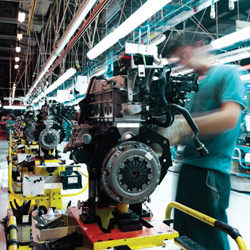
It’s not your father’s manufacturing world anymore.
Years back, a young person who was “good with his/her hands” could walk out of high school and into a factory job that paid a substantial wage. Good enough to support a family, pay the bills, buy a few toys and put everyone through school.
There was a time in this country when our industrial dominance was unquestioned. The majority of Americans worked in manufacturing or a related sector. We had brainpower, technology, transportation systems, the best equipment and the most productive workers. We had access to capital, well-funded research labs and the most cost-effective business models. We had paid healthcare insurance and a nice pension. We had ingenuity, creativity, and hard-working leaders and workers with a stubborn commitment to success. And, most of all, the quality of our products and services was better than anywhere else in the world.
Demand for U.S.-manufactured products kept the traditional middle class more in the upper-middle. We made more cars, more planes, more tractors, more machine tools—more of the bigger stuff than anyone in the world. Incomes and buying power outpaced inflation.
Fast forward to today. In 2009, the State of Illinois lost nearly 52,000 industrial jobs, and 709 manufacturing companies either closed their doors or left the state. Think about that number: 709 companies. Gone.
The challenges facing today’s manufacturing leaders are well-documented: foreign competition, rising healthcare costs, insurance and other costs of doing business. Difficulty in attracting younger people with even the basic work and life skills necessary to be productive employees. Pressure to reduce costs, lower prices and improve quality and speed of delivery. And, perhaps the challenge that is the biggest concern of all: leadership complacency and resistance to change.
The current downturn, however, seems to have served as a wake-up call. Many local manufacturers, for years held captive (even if profitably so) to just a few major customers in traditional sectors such as construction equipment, agriculture or automotive, saw their business decline dramatically. The wait for things to “return to normal” was taking longer than anyone expected. As such, many began to finally realize the need to change to survive is greater than ever.
The fact is, manufacturing must change. We must become more diverse. We must invest in new technology, develop new products and become more innovative. We must embrace new sectors and look international. We must think differently if we are going to succeed in a global market.
The good news is that manufacturers are up to this challenge. We can reclaim Illinois’ manufacturing leadership and rebuild our employment base. To be sure, some manufacturing is likely gone forever. It is simply too difficult to compete on price in production of commodity products with entities located in nations that have dramatically lower labor costs and government-subsidized operations. But for those products in which quality is a driver of the purchase decision—and we can dramatically differentiate our value—the U.S. will always have a market for its manufacturing capabilities.
Too often we’ve seen business leaders content to stay the course, whether it’s remaining in a single industry sector, serving one vertical customer segment, or running the company in a certain way. With customer service, proximity, impeccable quality and a little luck, these companies may survive. But with the right attitude and a focus on the right things, U.S. manufacturers can overcome complacency, compete and win in the Next Generation. iBi

